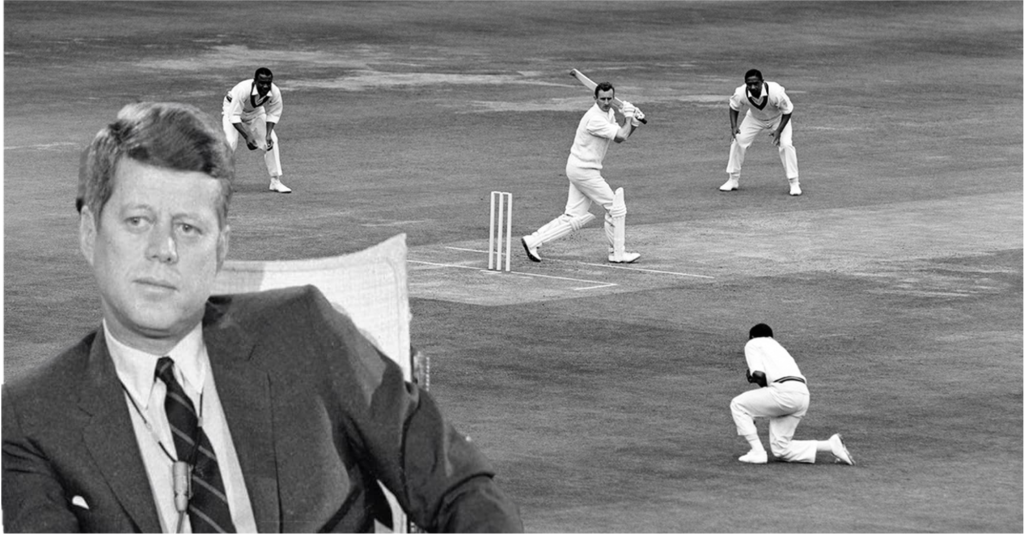For me, while values must be relevant to the fan’s deeper connections with the club, the key test is the extent to which they are adopted by people working at it and, especially, those serving the club on a match day.

'Ask Not What Your Fans Can Do for You': A Fan Engagement Primer for Cricket

Mark Bradley
@fanexperienceco
Mark works all over Europe helping associations, leagues and clubs to understand and improve fan engagement and their match day experience.
The Fan Experience Company was founded in 2005, and in 2019/20 they oversaw the assessment of over 350 games each season in 13 countries.
Of all of things JFK is remembered for, being a champion of customer engagement is perhaps one of the least known. But he did play a minor role in ensuring that business growth became founded on caring for customers, rather than on exploiting them. While football still struggles to fully comprehend this, I’m going to focus this article on showing how cricket can embrace Fan Engagement and use it to extend and diversify its reach and to increase attendances sustainably.
First, let me define Fan Engagement by charting the history of Customer Engagement: the business philosophy upon which it is based.
In the 50s and the 60s, growth was based simply on ‘making the sale’ and then moving on to the next customer. In this ‘sales’ era the principal aim was to condition the customer into buying something. Obviously, there was little consideration for the customer’s needs or after care. John F Kennedy became concerned about the long-term impact – if not checked – of such a myopic culture. He allegedly felt that poor ‘customer service’ would not only constrain business growth, but that it would also damage national pride and perceptions: the emotional foundation for everything to be achieved after the Second World War.
And emotion now sits at the heart of any progressive organisation’s growth strategy. In a few short decades, they have moved from conditioning customers to offering meaning and experiences that build an emotional bond with every individual. Product is trumped by experience and strategy is trumped by culture.
When I look at the evolution of growth strategies in spectator sports over the decades – especially at those clubs who rely on match day revenue for their viability – I see less evidence of progression and, on the contrary, much confused thinking. For example, even when we know how much the club means to fans, in place of showing them how valued they are, we simply prefer to sell tickets and the product is still considered to be the match itself. Strange indeed when you can’t control the outcome, so why not focus on the experiences of every person in the stadium? The idea of growing through personal engagement sounds attractive, so how do you do it in cricket?
Sport needs to pursue Customer Engagement and, because no fan wants to be called a customer, we’ll call it Fan Engagement.
Fan Engagement is not about the direct monetisation of fans, it’s about strengthening the emotional connection so that fans feel valued by the club and so that the conditions for growing the relationship are created. In the Introduction to Fan Engagement course I wrote for FC Barcelona’s Innovation Hub, I defined it thus:
‘Everything we do to understand, respect and grow the fan’s emotional investment in the club.’
Leaders in cricket need to ensure that they have the strategic and cultural components of engagement in place.
Over the years, we have refined what we see as the four key pillars of Fan Engagement: Meaning, Engagement, Experience and People. By meaning, we refer to the identity of the club. Beyond sporting glory, what does it truly represent, stand for or believe in? What values guide its decision making, especially in times of crisis.
Engagement is, effect, taking the one-way ‘broadcasting’ approach to communication and converting this into a continuous dialogue. While many clubs will already conduct surveys and hold fan panels, how many run short feedback surveys after every single game? Just three questions: please rate your experience today; tell us why you gave that rating and say what we could do to improve your personal experience next time.
There are many benefits of this approach, including the obvious one of knowing what to improve and where. But a less appreciated one is the ability over time to understand the impact of uncontrollable variables on fan perceptions (such as the team’s present performance, the time of the week when the game is played, the jeopardy level of each game and the quality of the opposition). Until The Hundred came along, the concept of the post-match short feedback survey just wasn’t happening.
Cricket clubs must take an obsessive interest in the Experience too. Each touch point should be mapped out, everyone must understand which ‘moments of truth’ matter to which groups of fans and, most important of all, leaders must prioritise learning and improvement. Once you start to measure the fan experience and compare different clubs’ performance at different touch points, not only are you able to introduce a little competition to ‘off the pitch’ performance, but you have a fount of learning that continually produces ‘best practices’ for other clubs to adapt and adopt.
In football, the EFL’s remarkable sequence of recent record attendances (the highest since 1959) has its roots in the Family Excellence scheme that we have run in partnership with them since 2007. In the first ten seasons of this award programme, clubs saw junior attendance rise by an estimated 37% (some 6 million new young fans). In essence, this is simply a league-wide feedback and learning commitment: something that could benefit County Cricket.
Finally, there is the people element: the ability of key match day staff to focus on enhancing the fan experience through pro-active engagement (rather than the traditional approach of, er, doing nothing other than standing around). In fact, my enjoyment of my first Hundred game was only hindered by the lack of knowledge and general ‘stand-offishness’ of the stewards we encountered. True, this is a problem in most sports. Most content themselves with the excuse that this service is contracted out while it would be so easy to lift perceptions with a basic combination of inspiration, development, reward and recognition.
Ultimately, it rests with the leaders of each club to recognise and act upon this opportunity and, handily, in addition to having the right KPIs in place (and we’ll come to that later), there is one simple act that should preface a new era of engagement at every club.
The CEO should, at least once a season, without telling anyone, purchase a ticket as a fan, using the usual channels, travel to the game, attempt to park and then walk the rest of the experience. Not only would I have each CEO report their experiences to other clubs’ leaders, but I would ask them to sit down with key colleagues and go through what they found.
Interestingly, this is an expectation that US Sports Commissioners make clear to their CEOs too: just one illustration that while you’ll always have a culture, a good leader creates the right one.
While KPIs have justified their place on the back on ‘what gets measured gets done’, they can often undermine more broader attempts to sow the seeds of culture change, especially if they reflect a belief in engagement purely in terms of monetisation. We must therefore focus on measures that encourage people within the club to focus on the ‘process’ of engagement, rather than the outcomes. For example, for first time fans, ‘likelihood to recommend’ (Net Promoter) is key, since we know from decades of research that the more likely someone is to recommend a provider, the stronger their loyalty. For existing fans, however, where there a pre-existing emotional connection, measures such as ‘how personally valued?’ will provide a more objective picture of engagement levels. Other areas worthy of KPIs where a culture of engagement is the aspiration are those relating to service recovery (‘complaints’ to you and me) and, of course, levels of personal engagement among the people who work for you.
With the uncertainties of the post-pandemic era; the multiple challenges of embracing a four-format future, increasing competition from other sports and the pull of digital entertainment, I firmly believe that a whole-hearted engagement strategy is the logical way to go. I am sure Kennedy would agree too. For did he not say ‘If not us, who? If not now, when?’.
For information on the Barça Innovation Hub Fan Engagement course, visit https://barcainnovationhub.com/product/certificate-in-fan-engagement/
Please email [email protected] if you’d like to discuss how The Fan Experience Company can help your league or club to flourish in the near future.
Find us at www.fanexperienceco.com
Want to read more by The Fan Experience Company?
Our white paper looks at the ways in which football clubs can get the right balance between safety and a great experience.
© The Fan Experience Company 2020

